Humboldt and Napa Counties established the first Farm Bureau offices in 1913, followed one year later by San Diego, Yolo and San Joaquin Counties. In 1917, several Mendocino County farmers recognized the value of bringing an Agricultural Extension Service into the county and began the process of forming a Farm Bureau.
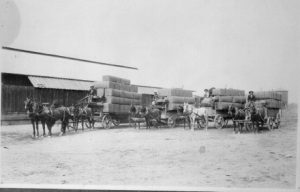
An act of Congress in 1914 along with an appropriation of $104,000 created a Cooperative Extension Service. Overseen by the Secretary of Agriculture and provided through land grant colleges, farm advisors started going into counties across the nation. Our land grant college, the University of California in Berkley, had already established an extension service but the appropriation from Congress provided the needed funding to place farm advisors in more counties throughout California.
The Farm Bureau movement was designed to provide an educational forum through Farm Centers, which were the satellite community units of the County Farm Bureau, maintained by the County Farm Advisors. The process of organization clearly started in University of California Circular 133, dated July 1915, stating that no Farm Advisor would be placed in the County until a County Farm Bureau was organized, with Farm Centers geographically located within the County. Also, one-fifth of all the farmers and ranchers in the County must be members, paying dues of one dollar per year.
Farm advisors brought university knowledge and research directly into the communities they served. This was demonstrated as counties having farm advisors recorded higher production than those without. The federal government and the State Council of Defense urged county farmers to form a Farm Bureau which was a requirement for sponsorship of a farm advisor. An abundance of food was needed as the government believed this would be a determining factor in the successful conclusion of World War I. Previous to this declaration by Congress, many commodity groups as the Stockmen and Grape Protection Associations formed in Mendocino County for various reasons but lacked the staff that could be provided through the U.C. system.
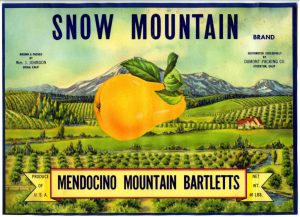
Newspapers featured front page articles on the success of farm advisors in other counties and the substantial benefit to agriculture with the program. Still many farmers in Mendocino County remained against the idea of possible higher taxes to pay for more agency officials.
Noted in a 1917 Dispatch-Democrat story – “There is no valid reasonable argument against working together for this move, there is no politics connected with it in any way as the US Government pays the salary and the University selects the man. The County pays expenses and the individual farmer puts in not more than $1 a year with the average farmer paying 20 cents, making a co-operative combination that has worked out successfully wherever tried in the United States.”
Signatures of 271 farmers out of the 1365 residing in Mendocino County needed to be obtained before the matter could be presented before the Board of Supervisors.
Meetings were held throughout Mendocino County and as a result an active campaign began in October 1917. Chairmen were T.J. Weldon, Ukiah; John Rupe, Willits; S.E. Brooks, Hopland; G.L. Magneson, Redwood Valley and James Eddie, Potter Valley. Each represented their respective district and was committed to the campaign to establish a Farm Bureau.
Redwood Valley was the first to form obtaining 40 signatures for their roll. A committee was immediately named to draft the constitution and bylaws. The committee was composed of: Mr. Yates, Mr. Wells, and Mr. Jamison. Redwood Valley’s effort was followed closely by Ukiah, Potter Valley, Willits and Fort Bragg. A petition of 280 signatures from these districts was presented to the Mendocino County Board of Supervisors at the December 10th, 1917 meeting along with the unanimous support from Anderson Valley which had just held their first discussion on the subject with Supervisor Rawles in attendance.
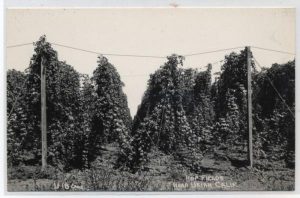
The Ukiah Times on December 12th, 1917 reported a stamp of approval by Supervisors which designated Ukiah as the headquarters for the Farm Bureau from which the farm advisor would receive his instructions. Supervisors urged other sections of the county to organize in time to greet a new farm advisor.
Mr. Charles Myszka entered the county in January 1918 and took up his farm advisor’s headquarters in a bat infested room used as storage by county schools and attended the first county wide meeting of the Farm Centers.
At this meeting F.A. Yates from Redwood Valley Farm Center was elected temporary chairman with Professor C.D. Flowers of Ukiah Farm Center as temporary secretary of the newly formed Mendocino County Farm Bureau. Main business for the day included the constitution and bylaws, election of directors-at-large as each Farm Center was allowed a representative to the Board, then four directors were elected at-large.
During the February meeting Farm Advisor Myszka announced that Anderson Valley, Round Valley, Point Arena, Hopland, Laytonville and Westport were working towards farm center formation. Willow, an area south of Ukiah around Burke Hill; Hopland, Carroll, Coyote Valley and Mendocino had formed.
Permanent officers were elected with F.A. Yates of Redwood Valley as president and J.G. Newman of Potter Valley as secretary. The directors were John Rupe, Willits; C. Crawford, Willow; L. Sawyers and C.D. Flowers, Ukiah; S.E. Brookes, Hopland; A.F. Busch, Potter Valley; H. Duveneck, Coyote Valley; N.W. Kent, Mendocino, L.O. Morby and J.C. Johnson of Hopland.
Business took the entire day as the establishment of a work program for the farm advisor was developed.
In March the first Mendocino County delegation attended the annual meeting of the County Farm Bureaus in Berkeley. President Yates, Secretary Newman, and Director S.E. Brookes of Hopland not only attended the week long meeting but also joined 150 other leaders on a journey of nine counties which included the San Joaquin Valley where a number of demonstrations were observed, four center meetings attended and 566 miles traveled. “These dedicated men” as reported in the local press “refused reimbursement and paid their personal expenses out of their own pockets.”
Farm Advisor Myszka submitted a year-end report which ran in all the county press. He summarized the activities of his first year in Mendocino County although he admitted being frustrated that more was not accomplished towards the war effort and around the county.
In reality, Myszka and that first Board of Directors really set an impressive record that first year. Membership went from 81 paid members in January to 258 members by December. Much of the year’s work was devoted to addressing the problems and concerns of agriculture. Records indicate the following was done:
Different farms visited, 523
Total number of farms visited, 778
Calls on agent seeking agricultural information in the office, 1,158
Letters written answering inquiries, 1,134
Circular letters written, 1,500
Total number of meetings, 82
Total attendance at meetings, 1,805
Miles traveled, 12,000
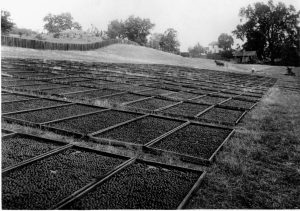
In addition: a Farm Bureau monthly was published giving news of interests to farmers, a marketing department was launched, Boys and Girls Clubs were started along with support for an agricultural program for high school students, demonstrations for pruning, planting, cover crops, irrigation, and fertilizing were held, “campaigns” were run to increase livestock and poultry production including predatory control, concerns on fire protection, septic systems, the building of roads and schools were addressed. Of course there were always the socials which kept rural communities together. Many a Farm Center meeting included potlucks and desserts with singing, poetry, plays and dancing.
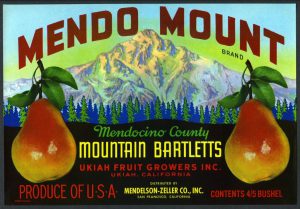
In 1919 many Farm Centers were going strong throughout the County, although some did not form until later due to the different degrees of receptiveness to Farm Bureau in each individual community. Active Centers became strong by developing a community based program of work which was assigned to committees to carry out. Farm Advisor Myszka helped plan the programs directed some of them and reported on all of them in an annual report of progress. The remarkable accomplishments of the local Extension Service and Farm Bureau were made possible by defining local goals and developing community support. It was a simple formula that worked exceedingly well.
J.G. Newman of Potter Valley was elected president in 1919. Directors on the Board included A.F. Busch also of Potter Valley; O. Lovestedt and F.A. Yates of Redwood Valley; Fred Waugh of Ukiah, J.C. Johnson of Hopland and C.E. Moffitt of Laytonville. It is not clear who else served on the Board that year but it is believed M.L. Sawyers and Greene Burke were also directors.
The Mendocino County Farm Bureau and all the Farm Centers continued their work and improvement programs. Other activities were started such as an annual picnic, prize winning fair displays at local and state fairs were arranged and youth agricultural programs were supported.
It should also be noted that farmers in Farm Bureau at this time became more active in other areas. The political arena was one of these areas and soon the U.C. Extension Service found itself in an uncomfortable situation. Since the University could not participate in politics, a decision was made to separate into two groups that year, each to remain independent of the other but closely tied. The Farm Advisor and Farm Bureau continued to share office space and programs although each had its own identity.
In 1919 a movement was also started to organize a state Farm Bureau federation as most counties had established a Farm Bureau at this time. On October 22, 1919 County Farm Bureaus sent representative to Berkeley to consider the formation of a state federation. Thirty-one counties responded and J.C. Johnson represented Mendocino County Farm Bureau. Mr. Johnson became one of the first elected state Farm Bureau directors and his name can be found on the original Articles of Incorporation.
After the first full year of work by the Extension Service, the budget allocated by the Board of Supervisors was not questioned. However, three years later in 1921 a group of local attorneys appeared before the Board asking that funds for Extension work be eliminated. The reason offered was concern for the developing power evidenced by Farm Bureau in the political and governmental affairs of the county. The opposition was of some concern to the Farm Bureau but was successfully handled by members of the organization.
Enough cannot be said about those early leaders who traveled long distances to take an active roll either in Farm Bureau meetings or working with other centers to develop their programs. Farm Bureau’s growth was slow, but the farmers of the time were determined. During some years of low prices it was very difficult to maintain interest and membership, but many hard working directors and members kept the organization moving forward.
Noted leaders during the early years of the Mendocino County Farm Bureau that have not been mentioned included:
Redwood Valley
Lee Smith, W. Hetrick, U.S. Gantz, E.V. Watson and George King
Potter Valley
Hopper, J.C. Thornton, R.R. Ingels and A.F. Whitaker
Round Valley
Redemeyer, J.B. Bellatti, D.T. Johnson, Ed Long and G.M. Biggar
Upper Lake
Charles Sanborn
Hopland
Charles Swanfelt, T.J. Hiatt, D.J. Henderson, J.W. Stutsman, James Clendening, D.R. McCleary, C.E. Leek, J.E. Williams and M. Lafranchi
Long Valley
Royce Davidson and J.A. Montgomery
Willits
Geo Davis, Charles Tuck, Hallie Case, W.T. Clow, A.J. Muir, Wm. Muir, J. Allenby, W.T. Ainsworth and Frank Whitney
Anderson Valley
Byron Gowan, I.C. Burke, T. Ornbaun, F.H. Brown, F. Rawles, F.B. Cook, R.T. Hutshell and C.H. Clow
Central
Hanby Ford, P.E. McKinney, L.L. Hooper and E.R. Taylor
In 1922, Farm Advisor Myszka was becoming overworked and in September of that year Mr. Russell Foote was appointed as Assistant Farm Advisor.
In 1928 Farm Bureau membership reached its early peak of 518 family members belonging to ten farm centers. Earlier, several Ukiah Valley Centers consolidated to form one.
In 1929, the effects of the great depression started a decline in membership. Many families lost their farms due to foreclosure and the lack of available agricultural financing. Once the dues were lowered in the early 1930’s, Farm Bureau membership rebounded.
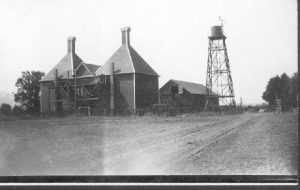
During this time, Farm Advisor Myszka stated that the momentum in Farm Bureau was not lost since major goals on projects had been realized. These beginning projects are still evident today in infrastructure such as septic systems, schools, road systems, the Potter Valley irrigation system or through other programs such as the federal predator program, the licensing of dogs in the county, commodity marketing programs, eradication of several livestock diseases and the formation of 4-H and FFA.
The original marketing program and Farm Bureau nursery led to the formation of a Farm Supply. The Mendocino County Farm Supply was incorporated April 7, 1949 in Ukiah. It was a cooperative enterprise with capital interest bearing stock, profits being returned to customers based on their dollar purchases. All capital stock was eventually paid off. Farm Bureau members remain as the major stock holder.
Since the beginning, Farm Bureau’s Board of Directors has met in many different places around Ukiah. The Farm Advisors office was used for several years and until the Board of Directors considered purchasing a lot to build a facility for Farm Bureau, Farm Supply and CalFarm insurance. To start the process, the Board of Directors sold low bearing interest certificates to the membership and others that were interested. Through this process enough funds were raised to start the construction of a new building on North State Street. Unfortunately, the proposed relocation of Highway 101 in the early 1960s was slated to be built through the planned Farm Bureau building site. After much debate, another site was selected on the north bank of Ackerman Creek on State Street. With financing from the Mendocino County Savings Bank, the new Farm Bureau building was completed which housed CalFarm insurance, Farm Supply and Farm Bureau.
During the record storms of 1964, Ackerman Creek flooded the complex and a number of records and other important documents were destroyed. To avoid future damage, another site for the Farm Bureau building was discussed. When the Ukiah Fruit Growers packing house building on Talmage Road became available in the 1978, it was decided to purchase that property. The old packing house building now houses the Farm Supply and a new office complex, built to the west of the existing buildings, currently houses Farm Bureau and other tenants.
The Mendocino County Farm Bureau secretarial staff members were volunteers for many years and they gave a lot of their time and effort to the organization. Mr. Hetrick of Calpella-Redwood Valley area served for several consecutive years as a volunteer. Some of the first paid staff were Don Ward of Hopland, Fred Solinger of Hopland, Ernie Pauli of Potter Valley and Bob Brown of Ukiah (who organized the first building fund for the Farm Bureau). Other office managers have included Antoinette Royer, Mayne Williams, Gary Hurn, Terry Bryant, Del Little and Carre Brown.
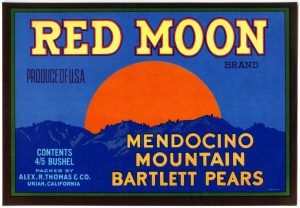
The Board of Directors was expanded over the years to currently include up to 34 directors representing specific areas of the County, mimicking the Farm Centers that no longer exist.
Throughout its history, Mendocino County Farm Bureau has maintained a lasting relationship with U.C. Cooperative Extension to promote and provide education to the agricultural industry in Mendocino County. Successful relationships with other local agricultural organizations, as well as other non-profits, elected officials and community activists have kept Farm Bureau as one of the most important organizations of our County.
Ukiah, Calif., Nov. 1, 1921
Mr. Farmer:
You are earnestly solicited to become a member of The Mendocino County Farm Bureau. This organization is devoted entirely to your interests and is entitled to your strongest support, morally and financially. The cost, as compared to results, is so little you cannot afford to stay out. The dues for the year 1922 have been placed, in this county, at $5.00 a year–$1.50 of this pays the State and National Farm Bureau Federation dues, $1.00 is retained by the local farm center for current expenses and $2.50 is for County Farm Bureau activities. The $5.00 dues, entitles the head of the house to membership and includes wife and minor children. National activities are devoted to assistance in all cases of interest to farmers, such as marketing, transportation, legislation, taxation and all other matters pertaining to agriculture. The state organization covers the same territory in a state-wide way and your county Farm Bureau looks to local needs and puts the necessary information up to the state and national organization.
The membership drive for 1922 will be conducted in the entire county during the week beginning, Monday, November 21. You will be asked by your neighbor to join this great co-operative organization, and to take an active part in its efforts and accomplishments during the years ahead. The Farm Bureau, at the present time is doing more for all the people than any other single or combined activity in the county. Its purposes are, better farming conditions, education in more production, better marketing methods and a general changing of agriculture from one of the lowest to the highest vocations.
As growers your welfare is the most important fact in the advancement of our nation and it is up to you to demonstrate to every one you are entitled to everyone’s best consideration.
MENDOCINO COUNTY FARM BUREAU
H. BROWN, President


